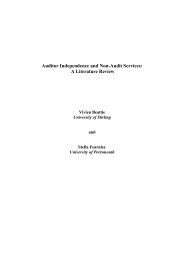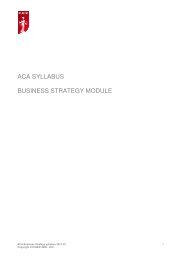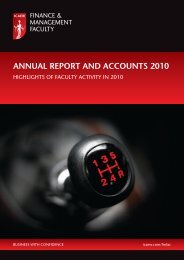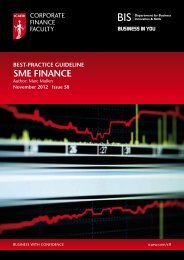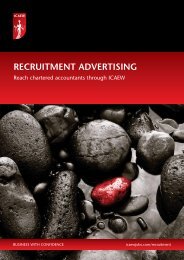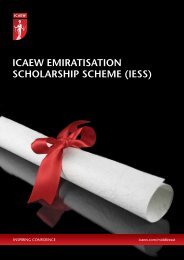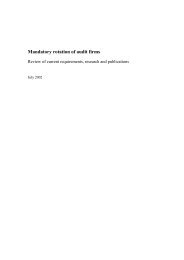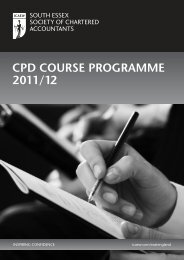O<strong>the</strong>r ethical decision-mak<strong>in</strong>g models are concerned more with <strong>the</strong> means as <strong>the</strong>y are basedon behav<strong>in</strong>g accord<strong>in</strong>g to a set of moral pr<strong>in</strong>ciples, such as Kant’s adherence to a set of dutiesor Plato’s concern <strong>for</strong> good ‘character.’ 181 This need not necessarily be a polarised conflictbetween what is pragmatic and what is ‘right’, as <strong>the</strong> utilitarians’ consequences may <strong>in</strong>cludehow people feel about <strong>the</strong> means used and adverse consequences may affect <strong>the</strong> discharge of aduty or character trait (considered fur<strong>the</strong>r below).8.2.3 Subjectivity and <strong>in</strong>commensurabilityTo measure requires quantification, at least to some extent. Some measurements typically lend<strong>the</strong>mselves to quantification, examples be<strong>in</strong>g <strong>in</strong>come, expense or time. However, o<strong>the</strong>rs donot, <strong>for</strong> example contentment, or <strong>in</strong>convenience. Without some sort of quantification, issues of<strong>in</strong>commensurability arise.Panel 8.2: Examples of <strong>in</strong>commensurabilityAn example fac<strong>in</strong>g <strong>in</strong>dividuals might be when look<strong>in</strong>g <strong>for</strong> a new car: how do you compare<strong>the</strong> respective merits of more luggage space, lower fuel consumption and air condition<strong>in</strong>g?Quality cannot be measured realistically without a generally accepted def<strong>in</strong>ition or standardto assess it aga<strong>in</strong>st and that is not always available.An example with wider impact is <strong>the</strong> current debate <strong>in</strong> <strong>the</strong> UK over proposals to build anew rail l<strong>in</strong>k (known as ‘High Speed 2’) from London, through some unspoilt and attractivecountryside <strong>in</strong> Buck<strong>in</strong>ghamshire, to <strong>the</strong> English Midlands and later <strong>the</strong> North. Here abalance needs to be struck between a loss of amenity and a large amount of disruption <strong>for</strong>some, aga<strong>in</strong>st timesav<strong>in</strong>g and potential economic benefit, <strong>for</strong> o<strong>the</strong>rs. Here <strong>the</strong>re are issuesof subjectivity, <strong>in</strong>commensurability, weight<strong>in</strong>g if quantification can be achieved, potentialconflict of values and different expectations about potential benefits. This latter po<strong>in</strong>t <strong>in</strong>particular is an illustration 182 that even where <strong>the</strong>re is agreement as to what <strong>the</strong> <strong>public</strong> <strong>in</strong>terestobjective would be, <strong>the</strong>re can still be disagreements as to what <strong>the</strong> consequences will be.In this <strong>in</strong>stance it might be agreed that <strong>in</strong> <strong>the</strong> <strong>public</strong> <strong>in</strong>terest <strong>the</strong> decision will be based onwhe<strong>the</strong>r <strong>the</strong> economic benefit to <strong>the</strong> country exceeds a certa<strong>in</strong> amount, but <strong>the</strong>re are highlyvariable op<strong>in</strong>ions as to what extra economic activity <strong>the</strong> new l<strong>in</strong>e would produce, and where.Panel 8.3: UK competition policy and <strong>the</strong> <strong>public</strong> <strong>in</strong>terestA fur<strong>the</strong>r example of multiple aims that cannot easily be compared by measurement is UKcompetition policy.For many years assessment of <strong>the</strong> acceptability of takeovers and monopolies was based aon a ra<strong>the</strong>r generic ‘<strong>public</strong> <strong>in</strong>terest’ test. The Fair Trad<strong>in</strong>g Act 1973 went a little way towardsspecify<strong>in</strong>g <strong>the</strong> matters to be considered, stat<strong>in</strong>g:‘In determ<strong>in</strong><strong>in</strong>g … whe<strong>the</strong>r any particular matter operates, or may be expected to operate,aga<strong>in</strong>st <strong>the</strong> <strong>public</strong> <strong>in</strong>terest, <strong>the</strong> Commission shall take <strong>in</strong>to account all matters which appearto <strong>the</strong>m <strong>in</strong> <strong>the</strong> particular circumstances to be relevant and, among o<strong>the</strong>r th<strong>in</strong>gs, shall haveregard to <strong>the</strong> desirability –(a) of ma<strong>in</strong>ta<strong>in</strong><strong>in</strong>g and promot<strong>in</strong>g effective competition…;(b) of promot<strong>in</strong>g <strong>the</strong> <strong>in</strong>terests of consumers, purchasers and o<strong>the</strong>r users of goods andservices … <strong>in</strong> respect of … prices … quality and … variety…;(c) of promot<strong>in</strong>g …reduction of costs… development and use of new techniques and newproducts, and… new competitors <strong>in</strong>to exist<strong>in</strong>g markets;(d) of ma<strong>in</strong>ta<strong>in</strong><strong>in</strong>g and promot<strong>in</strong>g <strong>the</strong> balanced distribution of <strong>in</strong>dustry and employment <strong>in</strong><strong>the</strong> United K<strong>in</strong>gdom; and(e) of ma<strong>in</strong>ta<strong>in</strong><strong>in</strong>g and promot<strong>in</strong>g competitive activity <strong>in</strong> markets outside <strong>the</strong> United K<strong>in</strong>gdomon <strong>the</strong> part of producers of goods…’. 183This wide variety of aims potentially conflict. For example, help<strong>in</strong>g compete abroad cansometimes be assisted by allow<strong>in</strong>g <strong>the</strong> establishment of a large ‘national champion’ reduc<strong>in</strong>gcompetition at home. No guidance was given as to how <strong>the</strong>se matters should be balancedbut <strong>in</strong> pr<strong>in</strong>ciple it should be possible to work out, at least <strong>in</strong> money terms, <strong>the</strong> net ga<strong>in</strong>s andlosses to <strong>the</strong> national economy.181Flanagan, Values, Codes of Ethics and <strong>the</strong> Law.182Ano<strong>the</strong>r is at Section 5.2.183Wise, ‘Review of Competition Law and Policy <strong>in</strong> <strong>the</strong> United K<strong>in</strong>gdom’, Fair Trad<strong>in</strong>g Act.56Aggregation and decision
Panel 8.3: UK competition policy and <strong>the</strong> <strong>public</strong> <strong>in</strong>terest (cont<strong>in</strong>ued)In <strong>the</strong> UK Enterprise Act 2002, <strong>public</strong> <strong>in</strong>terest was directly preserved only <strong>for</strong> media mergers,where guidance was given that matters such as accurate presentation, free expressionof op<strong>in</strong>ion and plurality of views – ‘to <strong>the</strong> extent reasonable and practicable’ – would beconsidered. 184 In o<strong>the</strong>r cases <strong>the</strong> <strong>public</strong> <strong>in</strong>terest test was replaced by and large, with a purecompetition-based test, although <strong>the</strong> Secretary of State (that is, <strong>the</strong> UK government) reta<strong>in</strong>ed<strong>the</strong> power to <strong>in</strong>tervene <strong>in</strong> cases where <strong>the</strong> <strong>public</strong> <strong>in</strong>terest merited it. 185 This effectively seemedto be say<strong>in</strong>g that it is up to <strong>the</strong> government to determ<strong>in</strong>e <strong>the</strong> <strong>public</strong> <strong>in</strong>terest, which isconsistent with our observations <strong>in</strong> <strong>the</strong> next chapter on government authority.8.2.4 InteractionDecisions as to what someone should do, cannot usually be made <strong>in</strong> isolation: it is often <strong>the</strong>case that one person’s actions will <strong>in</strong>fluence those of o<strong>the</strong>rs.Game <strong>the</strong>ory works on <strong>the</strong> premise that to every action <strong>the</strong>re is a reaction by o<strong>the</strong>r ‘players’.The reaction can, <strong>in</strong> pr<strong>in</strong>ciple, be predicted by consider<strong>in</strong>g <strong>the</strong> rules of ‘<strong>the</strong> game’ although ithas been noted that <strong>in</strong> some circumstances <strong>the</strong>re are no rules: a freewheel<strong>in</strong>g game. In suchcircumstances it has been suggested that <strong>the</strong> premise should be that a player does not get outof <strong>the</strong> game more than he or she puts <strong>in</strong>to it. 186 If <strong>the</strong> likely reaction is not what is desired, <strong>the</strong>nei<strong>the</strong>r <strong>the</strong> <strong>in</strong>itial action needs to be changed, or a more lateral approach applied: change <strong>the</strong>players, change <strong>the</strong> rules, enlist allies, tie people <strong>in</strong> or change <strong>the</strong> added value. Commercialexamples of <strong>the</strong>se sorts of behaviour <strong>in</strong>clude subsidis<strong>in</strong>g <strong>the</strong> costs of products which <strong>the</strong>n needexpensive consumables, long-term exclusivity contracts, and add<strong>in</strong>g quality to <strong>the</strong> product.One key problem with game <strong>the</strong>ory is that it presupposes rational, <strong>in</strong><strong>for</strong>med behaviour by <strong>the</strong>o<strong>the</strong>r players. 187 As discussed fur<strong>the</strong>r below, this is not necessarily <strong>the</strong> case.8.2.5 Weight<strong>in</strong>g of <strong>in</strong>terestsFrom a <strong>public</strong> <strong>in</strong>terest perspective <strong>the</strong> key aspect is not <strong>the</strong> weight<strong>in</strong>g that one <strong>in</strong>dividualundertakes between his or her collection of <strong>in</strong>terests, but how <strong>the</strong> <strong>in</strong>terests of different<strong>in</strong>dividuals, groups and even societies, are weighted. It can be argued that <strong>the</strong>re should beno weight<strong>in</strong>g at all: ‘<strong>the</strong> good of any one <strong>in</strong>dividual is of no more importance, from <strong>the</strong> po<strong>in</strong>tof view …of <strong>the</strong> universe, than <strong>the</strong> good of any o<strong>the</strong>r’. 188 However, this does not recognisethat people have vary<strong>in</strong>g needs, abilities and relative <strong>in</strong>terests <strong>in</strong> an issue, hence <strong>the</strong> caveat:‘unless…<strong>the</strong>re are special grounds <strong>for</strong> believ<strong>in</strong>g <strong>the</strong> more good is likely to be realised <strong>in</strong> <strong>the</strong>one case than <strong>in</strong> <strong>the</strong> o<strong>the</strong>r.’This <strong>in</strong>convenient but real issue causes problems: ‘<strong>the</strong> most common and most durablesource of factions has been <strong>the</strong> various and unequal distribution of property’, which has been<strong>in</strong>terpreted also to <strong>in</strong>clude abilities. ‘Those who hold and those who are without property have189 190ever <strong>for</strong>med dist<strong>in</strong>ct <strong>in</strong>terests <strong>in</strong> society.’In practice, weight<strong>in</strong>g is applied <strong>in</strong> a wide range of decisions. Politicians, <strong>for</strong> example, will atleast <strong>in</strong> <strong>the</strong>ory, tend to have more regard to poorer/disadvantaged citizens when determ<strong>in</strong><strong>in</strong>gtaxation and social spend<strong>in</strong>g policies. This can be defended up to a po<strong>in</strong>t on utilitarian groundsas <strong>the</strong> marg<strong>in</strong>al value of one pound is greater <strong>for</strong> a poor person than a well off one. A counterargumentwould be that if this is taken to <strong>the</strong> extreme, taxation/benefits would cont<strong>in</strong>ue untileveryone had <strong>the</strong> same <strong>in</strong>come, reduce <strong>in</strong>centive and thus reduce <strong>the</strong> overall pot.With<strong>in</strong> <strong>the</strong> UK accountancy profession, such discussion as <strong>the</strong>re is <strong>in</strong> <strong>the</strong> profession’s codesand o<strong>the</strong>r writ<strong>in</strong>gs implies that ‘<strong>the</strong> <strong>public</strong> <strong>in</strong>terest’ has a sense of ‘majority satisfaction’: somesituations aris<strong>in</strong>g where part of <strong>the</strong> <strong>public</strong> would be satisfied at <strong>the</strong> expense of o<strong>the</strong>r parts. 191‘National security’ is often a trump card applied although even here o<strong>the</strong>r <strong>in</strong>terests cannotbe completely dismissed. An example of this is a seventeenth century English court casewhich decided that <strong>the</strong> K<strong>in</strong>g could remove vital m<strong>in</strong>erals from a private <strong>in</strong>dividual’s land as<strong>the</strong> tak<strong>in</strong>g was considered to ‘extend to <strong>the</strong> defence of <strong>the</strong> whole realm, <strong>in</strong> which everysubject hath benefit’. It was also ordered that <strong>the</strong> K<strong>in</strong>g should restore <strong>the</strong> land afterwards. 192184Department <strong>for</strong> Bus<strong>in</strong>ess Innovation and Skills, Enterprise Act 2002: Public Interest Intervention <strong>in</strong> Media Mergers.185Ibid.186Brandenburger and Nalebuff, ‘The Right Game: Use Game Theory to Shape Strategy’.187Rappeport, ‘Game Theory Versus Practice’.188Sidgwick quoted <strong>in</strong> Schultz, ‘Henry Sidgwick’.189James Madison, quoted <strong>in</strong> Faulhaber, ‘The Rise and Fall of ‘Self Interest’’.190Faulhaber, ibid, on Madison.191The Accountancy Foundation Review Board, Protect<strong>in</strong>g <strong>the</strong> Public Interest.192‘The K<strong>in</strong>gs Prerogative <strong>in</strong> Saltpetre’ discussed <strong>in</strong> Manfredo, ‘Public Use & Public Benefit: The Battle <strong>for</strong> Upstate New York’.Aggregation and decision57
- Page 1 and 2:
ACTING IN THE PUBLIC INTEREST:A FRA
- Page 3:
ACTING IN THE PUBLIC INTEREST:A FRA
- Page 9: Our framework is based around the k
- Page 12 and 13: The answers to these questions will
- Page 14 and 15: 2. INTRODUCTION2.1 Concepts of the
- Page 16 and 17: Accordingly, this report addresses
- Page 18 and 19: Panel 2.4: ICAEW and its public int
- Page 20 and 21: The Mediterranean republics needed
- Page 22 and 23: We set out a framework for discussi
- Page 24 and 25: 3. CREDENTIALS FOR INVOKINGTHE PUBL
- Page 26 and 27: By and large producers operate in s
- Page 29 and 30: the UK government set up a ‘Commi
- Page 31 and 32: 4. APPLICABILITY OF THE PUBLIC INTE
- Page 33 and 34: to be a public interest matter: fir
- Page 35: This highlights that there may be p
- Page 38 and 39: 5. THE RELEVANT PUBLIC5.1 ScopeIn o
- Page 40 and 41: 5.3 Geographical exclusionsGeograph
- Page 42 and 43: 6. THE RELEVANT PUBLIC’S WANTS6.1
- Page 44 and 45: • work, that is having some, havi
- Page 46 and 47: Panel 6.3: Weisbrod’s public inte
- Page 48 and 49: Having sought out representative op
- Page 50 and 51: 7. CONSTRAINTS TO WANTS7.1 Self-int
- Page 52 and 53: In terms of whether the relevant pu
- Page 54 and 55: Panel 7.5: Management of national d
- Page 56 and 57: Panel 7.6: ICAEW and clarity of val
- Page 58 and 59: 8. AGGREGATION AND DECISION8.1 Base
- Page 62 and 63: In this instance, while national se
- Page 65 and 66: 9. IMPLEMENTATIONA proposed action
- Page 67 and 68: • giving up where targets seem un
- Page 69 and 70: 9.2.1 Government authorityAt the st
- Page 71 and 72: 9.3 Infrastructure and support tool
- Page 73 and 74: 12. The framework proposes a signif
- Page 75 and 76: ibliographyAdler, Jonathan H, Perve
- Page 77 and 78: Goldstein, Eric A, ‘Defining the
- Page 79 and 80: Persky, Joseph, ‘Retrospectives:
- Page 81: The ICAEW is a founder member of th



